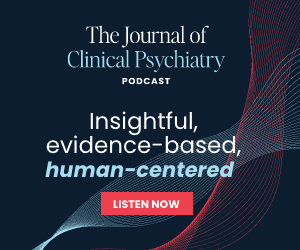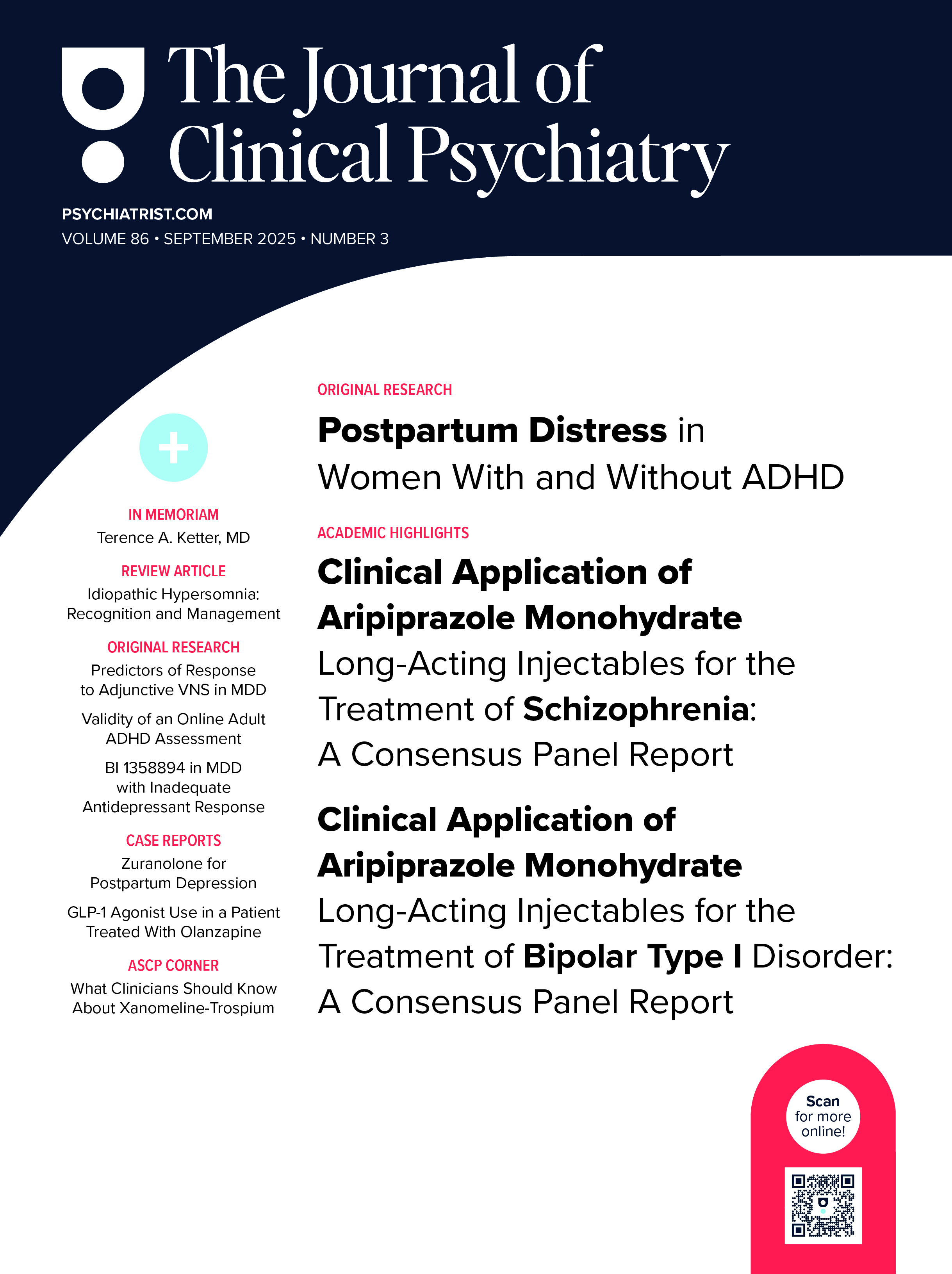This CME activity is expired. For more CME activities, visit CMEInstitute.com.
Find more articles on this and other psychiatry and CNS topics at The Journal of Clinical Psychiatry and The Primary Care Companion for CNS Disorders
Abstract
Attention-deficit/hyperactivity disorder (ADHD) is a common condition that can be difficult to diagnose in adolescents, since symptoms may vary among patients, evolve over time, and mimic symptoms of other disorders. Various rating scales are helpful to the clinician when evaluating patients for ADHD and should be used as part of a thorough assessment. Clinicians should use both informant- and self-report rating scales to gather as much information as possible, while being aware that informants are subject to rater error and adolescents typically underreport symptoms. Rating scales can establish a baseline measure of the patient’s symptom type and frequency, provide a framework for assessing symptom impairment, and aid clinicians in monitoring treatment response. The Adult ADHD Self-Report Scale (ASRS-v1.1) Symptom Checklist is a reliable self-report rating scale for adolescents as well as adults.
J Clin Psychiatry 2011;72(6):e20
From the Departments of Psychiatry and Child and Adolescent Psychiatry, New York University School of Medicine, and Psychiatry Service, New York VA Harbor Healthcare System, New York (Dr Adler); and the Division of Child and Adolescent Psychiatry, Department of Psychiatry, Mount Sinai School of Medicine, New York, New York (Dr Newcorn).
Supported by an educational grant from Shire.
Although ADHD is one of the most common psychiatric disorders among adolescents,1 no medical, genetic, or neurologic test exists to establish the diagnosis. Instead, ADHD is a clinical diagnosis in which physicians evaluate patients for the disorder using the clinical interview and informant reports to establish the duration, frequency, and severity of the patient’s symptoms, along with the patient’s degree of impairment.2
Diagnosing ADHD can be challenging, as symptoms may range from mild to severe, vary among patients, and be similar to those of other diagnoses such as ODD or mood disorders. Comorbid disorders are common among adolescents with ADHD and, along with other considerations such as substance use and learning disabilities, must be ruled out as the cause of symptoms.3,4 Informant reports are integral to diagnosing children with ADHD, but adolescents are not under the direct observation of parents or teachers as often or as long as children are, and, therefore, reports from teachers and parents are not as helpful as they are with younger patients. Establishing a longitudinal history is also more difficult, since doing so requires patients and parents to recall symptoms from several years earlier. Rating scales may help to overcome these diagnostic challenges in adolescent patients.
Considerations in Using ADHD Rating Scales
Informant- and self-report rating scales assess the frequency and severity of ADHD symptoms. Clinicians should gather informant-rated scales from multiple sources, including parents, teachers, and school counselors. Because teachers in middle and high schools may see adolescents for only an hour per day, clinicians should gather reports from more than 1 teacher and review current and previous school progress reports to look for patterns of behavior.2
However, the clinician should be aware that parent- and teacher-rated scales are subject to rater errors; for example, raters may tend to judge behavior too leniently or too severely, judge all items negatively or positively on the basis of one particular behavior, or rate items based on a previous rating that they feel they must follow logically.5 Parents may make errors by contrasting the child with siblings or with a particular referent, rather than with children of the same age without ADHD. Parents and teachers may also rate the patient based on their most recent behavior, rather than their behavior over time. Appraising informants and gathering information from multiple sources can help the clinician to evaluate the ratings and place them in their proper context.
Self-report scales can be used in conjunction with parent- and teacher-rated scales to evaluate ADHD symptoms prior to diagnosis and are also useful for measuring subsequent treatment response.6 However, when comparing reports from adolescents and their parents, adolescents tend to substantially underreport symptoms and symptom impairment.7 The greatest disagreements between the ratings of parents and those of adolescents are in the areas of relationships with friends, peers’ delinquent behaviors, and leisure activities.8 Reasons identified for these differences include (1) parents not being aware of the adolescent’s behaviors, (2) parents and adolescents interpreting the questions differently, and (3) parents and adolescents considering symptoms to be problematic at different levels.
Clinicians should become familiar with ADHD rating scales and their purposes (ie, parent/teacher-report scales, self-report scales, scales targeted to certain age groups, diagnostic and symptom scales, and executive function scales), and choose the ones that they are comfortable using. Rating scales do not replace the clinical interview, but a patient’s responses to particular symptom questions on a scale can guide the clinician’s attention to areas that might require more specific inquiry. Using scales to quantify symptoms—and thereby establish a baseline of symptom frequency—allows the clinician to target particular symptoms and then monitor them for treatment response.
Using the ASRS-v1.1 With Adolescents
One readily available self-report scale is the 18-item ASRS-v1.1 Symptom Checklist [E-Media link “ASRS v1.1” to http://psych.med.nyu.edu/patient-care/adult-adhd-screening-test], a WHO instrument in the public domain that has been translated into numerous languages and is used in a variety of Eastern and Western countries. The ASRS is validated as an ADHD self-report scale for adults,9 and recent preliminary findings suggest it is also a valid and reliable self-report scale for adolescents.10 The questions in the ASRS are based on the ADHD diagnostic criteria in the DSM-IV-TR and differ from children’s scales in that they are designed to suit an older patient (for example, they delete any reference to play). The ASRS is structured to provide a context for the questions so that patients can more accurately report symptoms.
The ASRS consists of 2 parts: the 6-item Part A, which is used alone for screening purposes in adults,9 and the 12-item Part B symptom checklist, which is used if an adult screens positive for ADHD. Part A has not been verified as a screening instrument in adolescents, so when assessing this population, both Parts A and B should be used as a symptom inventory. Patients rate symptoms as occurring never, rarely, sometimes, often, or very often. This rating system allows for the separation of “never” and “rarely” answers, which are grouped as one rating in some scales.
Clinicians should further examine symptoms that the patient rates in the range of “often” or “very often”; some symptoms rated “sometimes” are also significant, and these are indicated on the form. These results provide the clinician with a roadmap to assess the impact of the symptoms and the patient’s impairment from the symptoms in different domains such as school, social, and family settings. For the most pervasive symptoms, the clinician can ask the following questions during the clinical interview:
- In what settings does the symptom occur?
- Are others aware of it?
- Is it worse for you than for others?
- Do others comment on it?
- What do you do to cope with it?
- How does it affect you?
Rating and discussing individual symptoms can provide a framework for discussing the impairments that individuals with ADHD have and help patients and their parents develop a greater understanding of the solutions available to treat these impairments.
Patients should complete the scale at the initial clinical visit to establish a baseline result and then again at regular intervals. The clinician can then track the changes in the total score and in the scores for target symptoms to evaluate the patient’s response to treatment. As a guideline, an overall symptom reduction of 30% indicates treatment response. Alleviating symptoms and their resulting impairment is the ultimate goal in treating adolescents with ADHD.
For Clinical Use
- Use informant- and self-report rating scales as part of a thorough assessment and evaluation of adolescents for ADHD and to establish a baseline of symptom frequency
- Be aware that informants may make rater errors, and adolescents typically underreport symptoms
- Discuss patient responses to rating scale questions in the clinical interview to evaluate impairment
- Use rating scales at regular clinical visits to assess treatment response
Abbreviations
ADHD = attention-deficit/hyperactivity disorder
ASRS = ADHD Self-Report Scale
DSM-IV-TR = Diagnostic and Statistical Manual of Mental Disorders, Fourth Edition, Text Revision
ODD = oppositional defiant disorder
WHO = World Health Organization
References
- Bloom B, Cohen RA, Freeman G, for the National Center for Health Statistics. Summary health statistics for US children: National Health Interview Survey, 2009. National Center for Health Statistics. Vital Health Stat Series 10. 2010;10(247).
- Wolraich ML, Wibbelsman CJ, Brown TE, et al. Attention-deficit/hyperactivity disorder among adolescents: a review of the diagnosis, treatment, and clinical implications. Pediatrics. 2005;115(6):1743–1746.
- Barkley RA. Attention-Deficit Hyperactivity Disorder: A Handbook for Diagnosis and Treatment. 3rd ed. New York, NY: The Guilford Press; 2006.
- Hurtig T, Ebeling H, Taanila A, et al. ADHD and comorbid disorders in relation to family environment and symptom severity. Eur Child Adolesc Psychiatry. 2007;16(6):362–369.
- Conners CK. Rating scales in attention-deficit/hyperactivity disorder: use in assessment and treatment monitoring. J Clin Psychiatry. 1998;59(suppl 7):24–30. [E-Media: link to http://www.psychiatrist.com/private/supplenet/v59s/v59s07.pdf#page=26]
- Robin AL, Vandermay SJ. Validation of a measure for adolescent self-report of attention deficit disorder symptoms. J Dev Behav Pediatr. 1996;17(4):211–215.
- Smith BH, Pelham WE Jr, Gnagy E, et al. The reliability, validity, and unique contributions of self-report by adolescents receiving treatment for attention-deficit/hyperactivity disorder. J Consult Clin Psychol. 2000;68(3):489–499.
- Kramer TL, Phillips SD, Hargis MB, et al. Disagreement between parent and adolescent reports of functional impairment. J Child Psychol Psychiatry. 2004;45(2):248–259.
- Kessler RC, Adler L, Ames M, et al. The World Health Organization Adult ADHD Self-Report Scale (ASRS): a short screening scale for use in the general population. Psychol Med. 2005;35(2):245–256.
- Adler LA, Shaw DM, Spencer TJ, et al. Reliability of the ADHD Self Report Scale (ASRS) v1.1 Symptom Checklist to rate adolescent ADHD symptoms. Poster presented at: American Academy of Child and Adolescent Psychiatry 57th Annual Meeting; October 29, 2010; New York, NY.
This CME activity is expired. For more CME activities, visit CMEInstitute.com.
Find more articles on this and other psychiatry and CNS topics at The Journal of Clinical Psychiatry and The Primary Care Companion for CNS Disorders
CME Background Information
Supported by an educational grant from Shire.
Objectives
After completing this educational activity, you should be able to:
- Assess adolescent patients for ADHD using patient self-report/parent-report rating scales
- Evaluate the results of patient self-report/parent-report rating scales during assessment of an adolescent patient with ADHD
Financial Disclosure
The faculty for this CME activity and the CME Institute staff were asked to complete a statement regarding all relevant personal and financial relationships between themselves or their spouse/partner and any commercial interest. The CME Institute has resolved any conflicts of interest that were identified. No member of the CME Institute staff reported any relevant personal financial relationships. Faculty financial disclosures are as follows:
Dr Adler, in the last year, has received grant/research support from Bristol-Myers Squibb, Shire, Eli Lilly, Organon, Ortho McNeil/Janssen/Johnson & Johnson, and NIDA; was a member of the speakers bureaus for Ortho McNeil/Janssen/Johnson & Johnson and Shire; was a member of the advisory board and/or was a consultant for Abbott, AstraZeneca, Eli Lilly, Major League Baseball, Mindsite, Ortho McNeil/Janssen/Johnson & Johnson, Organon, Otsuka, Shire, and Epi-Q; was a consultant for i3 Research and INC Research; and received royalty payments from NYU (as inventor) for license of adult ADHD scales and training materials.
Dr Newcorn is a consultant for and has received honoraria from AstraZeneca, Biobehavioral Diagnostics, Shire, Ortho-McNeil-Janssen, Novartis, Eli Lilly, and Schering-Plough and has received grant/research support from Eli Lilly, Ortho-McNeil-Janssen, and Shire.
Accreditation Statement
The CME Institute of Physicians Postgraduate Press, Inc., is accredited by the Accreditation Council for Continuing Medical Education to provide continuing medical education for physicians.
Credit Designation
The CME Institute of Physicians Postgraduate Press, Inc., designates this educational activity for a maximum of 0.5 AMA PRA Category 1 Credit™. Physicians should only claim credit commensurate with the extent of their participation in the activity.
To obtain credit for this activity, study the material and complete the CME Posttest and Evaluation.
Release, Review, and Expiration Dates
This Psychlopedia activity was published in March 2011 and is eligible for AMA PRA Category 1 Credit through March 31, 2014. The latest review of this material was March 2011.
Statement of Need and Purpose
Diagnosing ADHD is difficult, and, due to using differing methods of assessment, prevalence rates vary greatly from region to region. Clinicians may have difficulty recognizing the disorder because hallmark symptoms of ADHD, such as inattentiveness, distractibility, and restlessness, can also characterize conditions such as depression, dysthymia, anxiety, or hypomania. Further, many ADHD symptoms are common in young healthy individuals. To help in accurately diagnosing ADHD, a number of rating scales and screening tools are available, but many of these instruments also rely on subjective reporting of symptoms commonly associated with ADHD. Clinicians need additional education in teaching adolescents and their parents how to complete self-report scales and then how to interpret the results of those self-report scales in a meaningful way. For example, clinicians need to be able to determine if the symptoms and impairments noted are indicative of ADHD, are independent of a psychiatric disorder, or are related to a psychiatric disorder other than ADHD prior to rendering a diagnosis. In addition, clinicians need more information about the importance of continued assessment following an initial ADHD diagnosis. This activity was designed to meet the needs of participants in CME activities provided by the CME Institute of Physicians Postgraduate Press, Inc., who have requested information on ADHD.
Disclosure of Off-Label Usage
Dr Adler has determined that, to the best of his knowledge, no investigational information about pharmaceutical agents that is outside US Food and Drug Administration–approved labeling has been presented in this activity.
Review Process
The entire faculty of the series discussed the content at a peer-reviewed planning session, the Chair reviewed the activity for accuracy and fair balance, and a member of the External Advisory CME Board who is without conflict of interest reviewed the activity to determine whether the material is evidence-based and objective.
Acknowledgment
This Psychlopedia activity was derived from the planning teleconference “Using Diagnostic and Assessment Tools for Adolescents With ADHD,” which was held on November 22, 2010, and was supported by an educational grant from Shire. The opinions expressed herein are those of the faculty and do not necessarily reflect the opinions of the CME provider and publisher or the commercial supporter.


